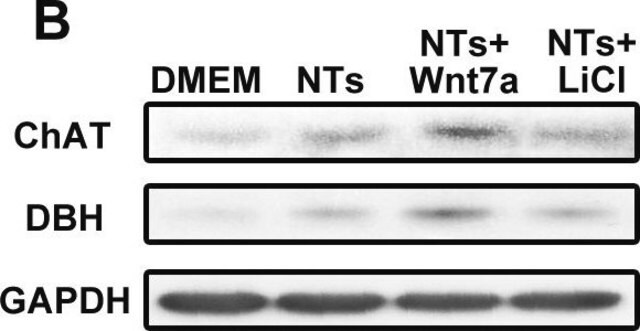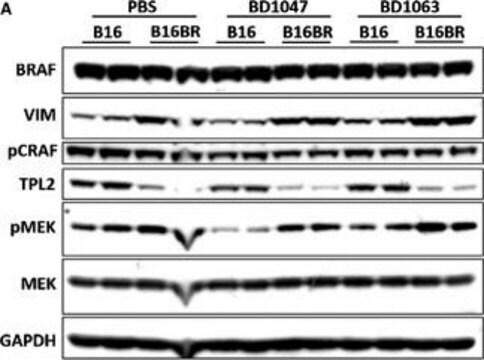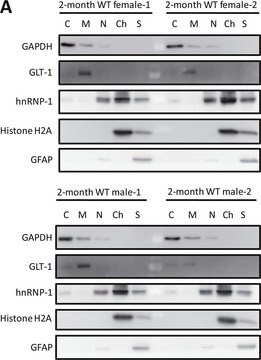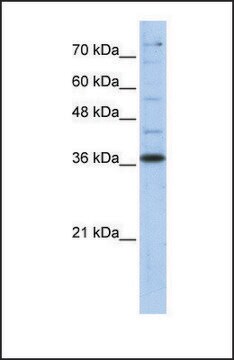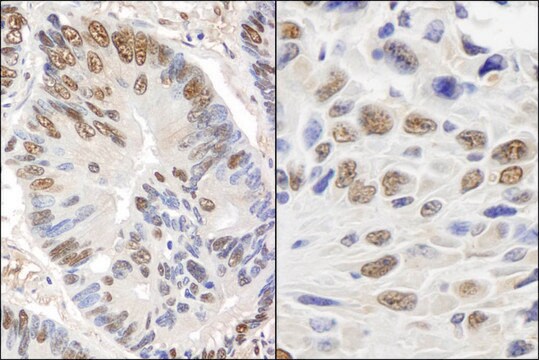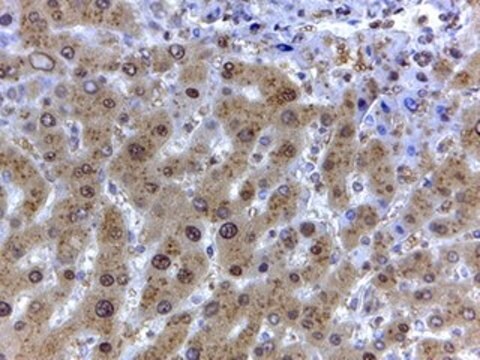G8795
Monoclonal Anti-GAPDH
clone GAPDH-71.1, purified from hybridoma cell culture
Sinonimo/i:
Anti-G3PD, Anti-G3PDH, Anti-Glyceraldehyde-3-phosphate dehydrogenase
About This Item
Prodotti consigliati
Origine biologica
mouse
Livello qualitativo
Coniugato
unconjugated
Forma dell’anticorpo
purified from hybridoma cell culture
purified immunoglobulin
Tipo di anticorpo
primary antibodies
Clone
GAPDH-71.1, monoclonal
Forma fisica
buffered aqueous solution
PM
antigen ~37 kDa
Reattività contro le specie
bovine, turkey, canine, chicken, monkey, mink, mouse, human, rabbit, rat, hamster
Non deve reagire con
prokaryotes
Confezionamento
antibody small pack of 25 μL
Concentrazione
~1 mg/mL
tecniche
immunocytochemistry: suitable
indirect ELISA: suitable
microarray: suitable
western blot: 0.025-0.05 μg/mL using A431 total cell extract
Isotipo
IgM
N° accesso UniProt
applicazioni
research pathology
Condizioni di spedizione
dry ice
Temperatura di conservazione
−20°C
modifica post-traduzionali bersaglio
unmodified
Informazioni sul gene
human ... GAPDH(2597)
mouse ... Gapdh(14433)
rat ... Gapdh(24383)
Descrizione generale
Specificità
Immunogeno
Applicazioni
- protein extracted from heart tissue of mice at a working dilution of 1:25,000
- myelin and axogliasomal fractions from human CNS
- nuclear and cytoplasmic fractions from TBP-13Q and TBP-105Q PC12 cells following recovery from heat shock
- protein from bovine immortalized luteal endothelial cells
- renal tubular epithelial cell extract
- proteins from mouse embryonic fibroblasts
- protein extract from ventricular myocardium tissues
- A431 total cell extract at a working concentration of 0.025-0.05μg/mL
Azioni biochim/fisiol
Stato fisico
Stoccaggio e stabilità
For extended storage, freeze in working aliquots. Repeated freezing and thawing, or storage in “frostfree” freezers, is not recommended. If slight turbidity occurs upon prolonged storage, clarify the solution by centrifugation before use. Working dilution samples should be discarded if not used within 12 hours.
Esclusione di responsabilità
Non trovi il prodotto giusto?
Prova il nostro Motore di ricerca dei prodotti.
Prodotti correlati
Raccomandato
Codice della classe di stoccaggio
12 - Non Combustible Liquids
Classe di pericolosità dell'acqua (WGK)
WGK 1
Punto d’infiammabilità (°F)
Not applicable
Punto d’infiammabilità (°C)
Not applicable
Dispositivi di protezione individuale
Eyeshields, Gloves, multi-purpose combination respirator cartridge (US)
Certificati d'analisi (COA)
Cerca il Certificati d'analisi (COA) digitando il numero di lotto/batch corrispondente. I numeri di lotto o di batch sono stampati sull'etichetta dei prodotti dopo la parola ‘Lotto’ o ‘Batch’.
Possiedi già questo prodotto?
I documenti relativi ai prodotti acquistati recentemente sono disponibili nell’Archivio dei documenti.
I clienti hanno visto anche
Articoli
Loading controls in western blotting application.
We presents an article about the Warburg effect, and how it is the enhanced conversion of glucose to lactate observed in tumor cells, even in the presence of normal levels of oxygen. Otto Heinrich Warburg demonstrated in 1924 that cancer cells show an increased dependence on glycolysis to meet their energy needs, regardless of whether they were well-oxygenated or not.
Il team dei nostri ricercatori vanta grande esperienza in tutte le aree della ricerca quali Life Science, scienza dei materiali, sintesi chimica, cromatografia, discipline analitiche, ecc..
Contatta l'Assistenza Tecnica.


